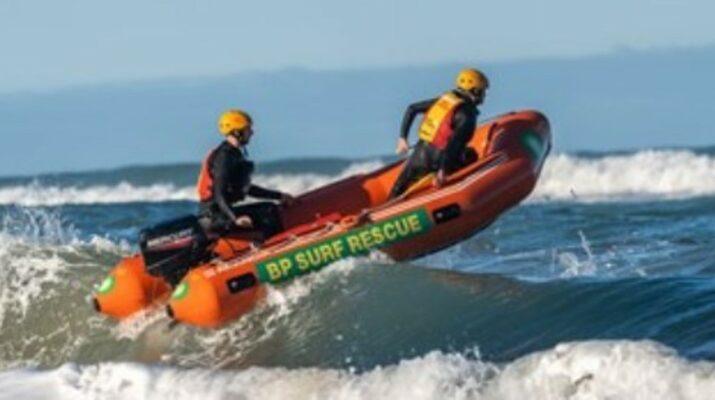Surf Life Saving New Zealand news
Despite the wet and gloomy weather in many areas, surf lifeguards across the country were kept busy on Christmas Day, with 13 rescues and 10 assists performed nationally. In total, more than 2,197 hours were spent patrolling Aotearoa New Zealand’s coastlines on Christmas Day, while 789 preventative actions by Surf Life Saving New Zealand (SLSNZ) surf lifeguards kept the public safe.
While many regions were relatively quiet, this did not stop the occurrence of several major incidents, including a mass rescue performed at Wainui near Gisborne, a multi-service (SLSNZ, Coastguard New Zealand, and Police) search and rescue operation for a missing kite surfer at Raglan, multiple rescues at Waipātiki, and the treatment and helicopter transfer of a suspected spinal injury at Whangamatā, involving SLSNZ surf lifeguards, Hato Hone St John, and Westpac Rescue Helicopter.
In the Raglan rescue, Coastguard New Zealand was notified by Police of a kite surfer in difficulty at the entrance to the Raglan Bar. They contacted the Raglan patrol, which was mobilised to provide support to the Coastguard New Zealand jetski. An IRB and all-terrain vehicle (ATV) responded and completed an initial search, before Coastguard located the patient and assisted them back to shore. Raglan also assisted two further patients who got into trouble while swimming.
2023-2024 Season Beach Safety Messages from SLSNZ:
- Know How To Float
If you don’t know how to float, don’t go into the water.
Just being able to float when you are in the water can increase your chance of survival. Floating allows you to calm yourself and keep your airways out of the water. It is also the first thing to do if you get caught in a rip.
If you don’t know how to float well, practice or get some lessons in a pool before you head to the beach – being able to float is a key skill when learning to swim. Anyone can learn to float but some people may take a little longer to learn.
- Find The Safest Place To Swim
Remember if you are heading to the beach, check www.safeswim.org.nz to find a lifeguarded beach, and always swim between the red and yellow flags, which show the safest place to swim. The surf lifeguards are there to help keep beachgoers safe, by keeping a constant eye on sea as they continuously scan for hazards or people in difficulty, keeping on top of weather forecasts and understanding the swell and tide conditions too.
- If In Doubt, Stay Out
Waves can be bigger than they look, dangerous rip currents are hard to spot and weather conditions can be unpredictable. If you feel uncomfortable about getting into the water, stay out. It’s better to be safe than sorry. Too many people get into trouble in the water because they overestimate their abilities and underestimate the conditions.
- Take Care of Others
Always keep children within arm’s reach in or near the water. Waves can move quickly and unexpectedly and can knock kids off their feet and sweep them away. Everyone has different levels of ability, so watch out for your mates too.
- Know How to Get Help
If someone in the water is in trouble and surf lifeguards are on patrol, let them know. If you can’t see any surf lifeguards, call 111 and ask for police. Police have a direct line to surf lifeguards and others who can help.
If you’re in the water and in trouble yourself, signal for help.

